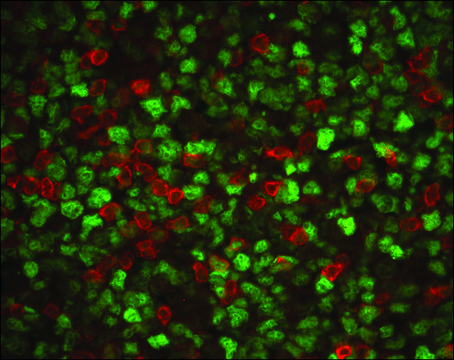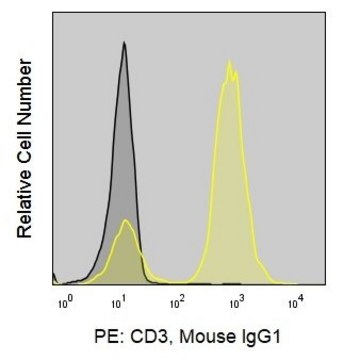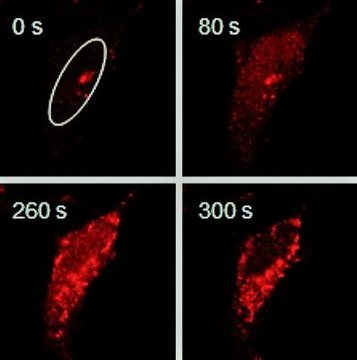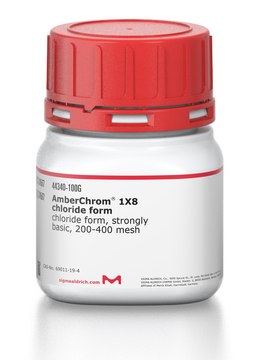MABF413
Anti-CD3 (mouse) Antibody, Alexa Fluor™647, clone 17A2
clone 17A2, from rat, ALEXA FLUOR™ 647
Sign Into View Organizational & Contract Pricing
All Photos(1)
Synonym(s):
T-cell surface glycoprotein CD3 epsilon chain, T-cell surface antigen T3/Leu-4 epsilon chain, CD3
UNSPSC Code:
12352203
eCl@ss:
32160702
NACRES:
NA.44
Recommended Products
biological source
rat
conjugate
ALEXA FLUOR™ 647
antibody form
affinity isolated antibody
antibody product type
primary antibodies
clone
17A2, monoclonal
species reactivity
mouse
technique(s)
activity assay: suitable
flow cytometry: suitable
immunohistochemistry: suitable
immunoprecipitation (IP): suitable
isotype
IgG2bκ
UniProt accession no.
shipped in
wet ice
Gene Information
mouse ... Cd3E(12501)
General description
CD3, also known as T3, is a member of the Ig and the ITAM superfamilies. The CD3 complex is composed of six polypeptides with usually four different transmembrane CD3 chains, gamma, delta, epsilon and zeta. CD3 is primarily expressed on T cells, NK-T cells, and at different levels on thymocytes during T cell differentiation. CD3 plays a critical role in TCR signal transduction, T cell activation, and antigen recognition by binding the peptide/MHC antigen complex. The CD3 antigen is present in early thymocytes, and has been considered the best all-around T cell marker. The positive staining of this marker may represent a sign of early commitment to the T cell lineage. In cortical thymocytes, during early stages of maturation, the CD3 antigen is predominantly present in the cell cytoplasm. In medullary thymocyles, the CD3 antigen is predominantly detected on the cell surface. The majority of T cell neoplasms also expresses CD3, but it is absent from non-T-cell lymphoid malignancies. CD3 complex plays an important role in coupling antigen recognition to several intracellular signal-transduction pathways. The genes encoding the epsilon, gamma and delta polypeptides are located in the same cluster on chromosome 11. The epsilon polypeptide plays an essential role in T-cell development. Defects in this gene cause immunodeficiency. This gene has also been linked to a susceptibility to type I diabetes in women.
Specificity
This antibody recognizes ε/γ (but not ε/δ) of the CD3 complex.
Immunogen
γδTCR-positive T-T hybridoma D1
Application
Anti-CD3 (mouse) Antibody, AlexaFluor647, clone 17A2 is a highly specific rat monoclonal antibody, that targets CD3 & has been tested in Flow Cytometry, IHC, Activity Assay & IP.
Immunohistochemistry Analysis: A previous lot detected human CD3 in Immunohistochemistry. (Zhang Y, et al. 2002; Miescher GC, et al. 1989.)
Immunoprecipitation Analysis: A previous lot detected human CD3 in Immunoprecipitation. (Miescher GC, et al. 1989.)
Activity Assay Analysis: A previous lot detected human CD3 in Activity Assay. (Miescher GC, et al. 1989.)
Immunoprecipitation Analysis: A previous lot detected human CD3 in Immunoprecipitation. (Miescher GC, et al. 1989.)
Activity Assay Analysis: A previous lot detected human CD3 in Activity Assay. (Miescher GC, et al. 1989.)
Research Category
Inflammation & Immunology
Inflammation & Immunology
Research Sub Category
Cytokines & Cytokine Receptors
Cytokines & Cytokine Receptors
Quality
The antibody was purified by affinity chromatography, and conjugated with AlexaFluor647 under optimal conditions. The solution is free of unconjugated AlexaFluor647 and unconjugated antibody. Alexa Fluor 647 is a registered trademark of Molecular Probes, Inc. Alexa Fluor 647 dye antibody conjugates are sold under license from Molecular Probes, Inc. for research use only, except for use in combination with microarrays and high content screening, and are covered by pending and issued patents.
Flow Cytometry Analysis: 0.25 μg of this antibody detected CD3 in one million C57BL/6 mouse splenocytes.
Flow Cytometry Analysis: 0.25 μg of this antibody detected CD3 in one million C57BL/6 mouse splenocytes.
Target description
21 kDa calculated
Physical form
Affinity
Purified rat conjugate antibody in buffer containing PBS (pH 7.2) with up to 0.1% sodium azide.
Storage and Stability
The antibody solution should be stored undiluted at 2-8°C and protected from prolonged exposure to light. Do not freeze.
Other Notes
Concentration: Please refer to the Certificate of Analysis for the lot-specific concentration.
Legal Information
ALEXA FLUOR is a trademark of Life Technologies
Disclaimer
Unless otherwise stated in our catalog or other company documentation accompanying the product(s), our products are intended for research use only and are not to be used for any other purpose, which includes but is not limited to, unauthorized commercial uses, in vitro diagnostic uses, ex vivo or in vivo therapeutic uses or any type of consumption or application to humans or animals.
WGK
WGK 2
Flash Point(F)
Not applicable
Flash Point(C)
Not applicable
Certificates of Analysis (COA)
Search for Certificates of Analysis (COA) by entering the products Lot/Batch Number. Lot and Batch Numbers can be found on a product’s label following the words ‘Lot’ or ‘Batch’.
Already Own This Product?
Find documentation for the products that you have recently purchased in the Document Library.
Our team of scientists has experience in all areas of research including Life Science, Material Science, Chemical Synthesis, Chromatography, Analytical and many others.
Contact Technical Service




